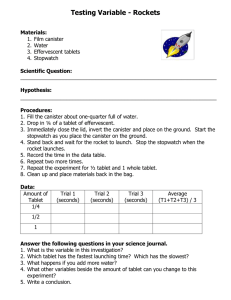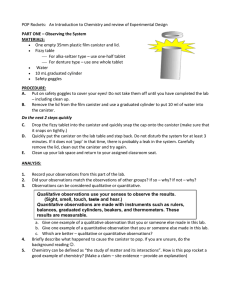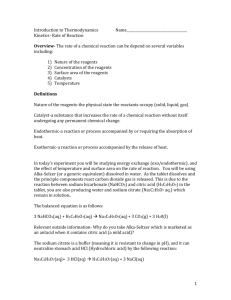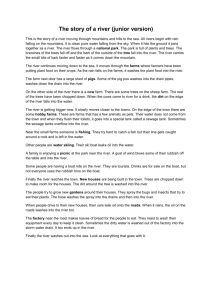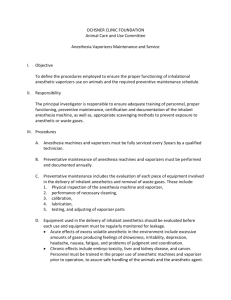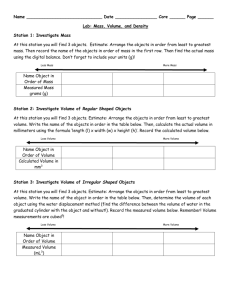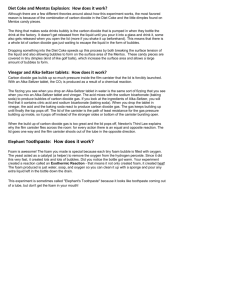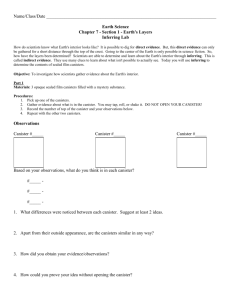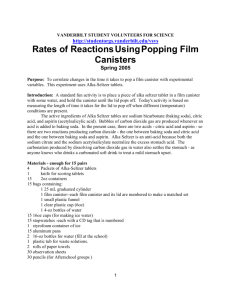Design Your Own Experiment
advertisement
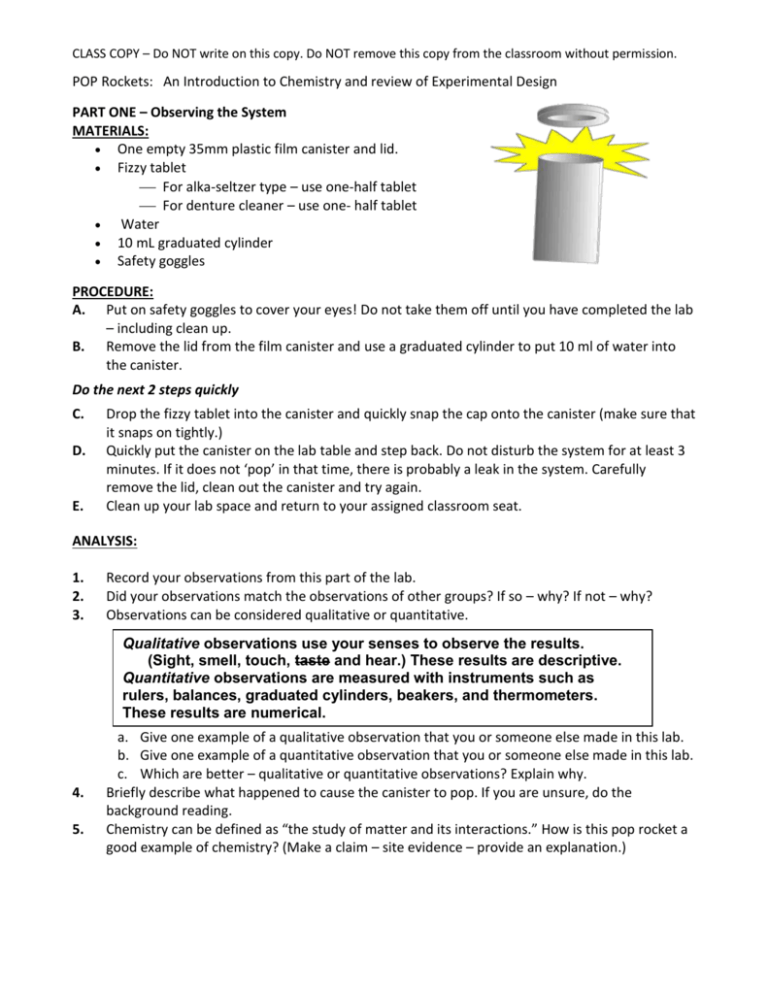
CLASS COPY – Do NOT write on this copy. Do NOT remove this copy from the classroom without permission. POP Rockets: An Introduction to Chemistry and review of Experimental Design PART ONE – Observing the System MATERIALS: One empty 35mm plastic film canister and lid. Fizzy tablet For alka-seltzer type – use one-half tablet For denture cleaner – use one- half tablet Water 10 mL graduated cylinder Safety goggles PROCEDURE: A. Put on safety goggles to cover your eyes! Do not take them off until you have completed the lab – including clean up. B. Remove the lid from the film canister and use a graduated cylinder to put 10 ml of water into the canister. Do the next 2 steps quickly C. D. E. Drop the fizzy tablet into the canister and quickly snap the cap onto the canister (make sure that it snaps on tightly.) Quickly put the canister on the lab table and step back. Do not disturb the system for at least 3 minutes. If it does not ‘pop’ in that time, there is probably a leak in the system. Carefully remove the lid, clean out the canister and try again. Clean up your lab space and return to your assigned classroom seat. ANALYSIS: 1. 2. 3. Record your observations from this part of the lab. Did your observations match the observations of other groups? If so – why? If not – why? Observations can be considered qualitative or quantitative. Qualitative observations use your senses to observe the results. (Sight, smell, touch, taste and hear.) These results are descriptive. Quantitative observations are measured with instruments such as rulers, balances, graduated cylinders, beakers, and thermometers. These results are numerical. 4. 5. a. Give one example of a qualitative observation that you or someone else made in this lab. b. Give one example of a quantitative observation that you or someone else made in this lab. c. Which are better – qualitative or quantitative observations? Explain why. Briefly describe what happened to cause the canister to pop. If you are unsure, do the background reading. Chemistry can be defined as “the study of matter and its interactions.” How is this pop rocket a good example of chemistry? (Make a claim – site evidence – provide an explanation.) CLASS COPY – Do NOT write on this copy. Do NOT remove this copy from the classroom without permission. BACKGROUND READING: The BASICS - There's nothing like a little rocket science to add some excitement to the day. When you add the water it starts to dissolve the fizzy tablet. This creates a gas called carbon dioxide. As the carbon dioxide is being released, it creates pressure inside the film canister. The more gas that is made, the more pressure builds up until the cap is blasted up. This system of thrust is how a real rocket works whether it is in outer space or here in the earth's atmosphere. Of course, real rockets use rocket fuel. MORE DETAIL – Rockets move by expelling fuel in one direction to move in the opposite direction (Newton's third law of motion). For our pop rockets, the thrust force comes from a pressure build-up caused by a chemical reaction. When the antacid tablet is placed in water, many little bubbles of gas are created. What exactly is going on? Antacid tablets contain aspirin, sodium bicarbonate (NaHCO3) and citric acid (H+). Bicarbonate compounds react with acids to form carbon dioxide and water. Something similar happens in other fizzy tablets. HCO3 + H+ H2O (liquid) + CO2 (gas) Figure 1. The basics of a pop-rocket In an antacid tablet, the bicarbonate and citric acid are solids and so the H+ and HCO3-1 ions are not free to move, collide and react. When plopped into water, the citric acid and sodium bicarbonate dissolve, freeing the ions to react. This results in the formation of carbon dioxide gas. The bubbles go up, instead of down, because they weigh less than water. When the bubbles get to the surface of the water, they break open. All that gas that has escaped from the bubbles pushes on the sides of the canister. Eventually, something has to give ─ the canister literally pops its top. All the gas rushes up and out, pushing the lid up and away. The lid (rocket) travels upward with a force that is equal and opposite to the downward force (Newton's third law of motion). The amount of force is directly proportional to the gas expelled from the canister and how fast it is expelled (Newton's second law of motion). PART TWO – Testing the System – Designing an Experiment Now that you are familiar with the pop rocket system, you will design and conduct a single-variable experiment to answer a testable question. POSSIBLE MATERIALS: Safety goggles film canister and lid – several types available fizzy tablet – several types available; multiple amounts possible (limit 2); water – room temperature, hot, cold, different amounts possible other liquids – rubbing alcohol (70% isopropyl alcohol); household vinegar graduated cylinder – 10 mL, 25 mL timer meter stick, tape measure Other: CLASS COPY – Do NOT write on this copy. Do NOT remove this copy from the classroom without permission. PROCEDURE: 1. Work in your lab team to choose a question. 2. Write your own TESTABLE QUESTION and a HYPOTHESIS to go along with it. Identify and label your INDEPENDENT VARIABLE and your DEPENDENT VARIABLE. 3. Your first experiment was your CONTROL GROUP. Remember that only ONE variable should be changed between your control group and your EXPERIMENTAL GROUP. List at least 4 things that will be kept CONSTANT between the 2 experiments. 4. Write the PROCEDURE you plan to use. Be sure to address any safety issues with your plan. 5. Design a DATA TABLE to record your data. 6. Your procedure must be checked for safety and initialed by the teacher before you may start the experiment. 7. Collect your materials and safely conduct your experiment. 8. Clean up your lab and write a conclusion (claim, evidence, explanation). Note to students: If you need help knowing what to write, refer to the “Designing an Experiment” packet and/or your PowerPoint Notes and/or your scientific methods vocabulary sheet. This experiment was adapted from “Build a Film Canister Rocket” found at http://www.sciencebob.com/experiments/filmrocket.php CLASS COPY – Do NOT write on this copy. Do NOT remove this copy from the classroom without permission. Design Your Own Experiment PLAN Question: Now that you’ve considered the possibilities and made some decisions, it is time to actually write up your plan. The plan will earn points according to the checklist. Some reminders: Clearly state your research question / problem. What is the impact of __(IV)__ on the __(DV)__ of __(system)__ ? Variables: Identify your variables (IV, DV, CV) The independent variable is… The dependent variable is… The following variables will be controlled (constants)… Hypothesis: State what you think will happen --- and why you think that… If the __(IV)__ is changed from ___ to ___ then the __(DV)__ will _____ because … Materials: List the materials you will use – be specific – include amounts and type Procedure: Describe what you will do with step-by-step instructions and/or a labeled diagram. Another student in this class should be able to follow your procedure to repeat your investigation. Data Table: Create an organized data table to record your data Remember to title your data table place the independent variable in the rows - with one row for each different way you are changing the independent variable. place the dependent variable in the columns – with each column representing a different trial - include units when applicable (title) (DV) (unit) Trial 1 (DV) (unit) Trial 2 (DV) (unit) Trial 3 (IV – change #1) (IV – change #2) (IV – change #3) DO Once your plan has been approved by your teacher, gather your materials, do your lab – collect your data, and clean up. The lab will earn points according to the checklist. CLAIM Write your conclusion for your lab. Make a claim – support it with evidence and offer your best explanation. The conclusion will earn points according to the checklist provided. CLASS COPY – Do NOT write on this copy. Do NOT remove this copy from the classroom without permission. Density Design Lab Checklist Your Name _____________________________________ Date _______________________________ Pd ________ This is a major assignment - Points for this lab will be multiplied by 4 ! Do your BEST work. 1. Planning [ 16 points TOTAL ] : [Note - This section will also be scored by the rubric on the reverse of this page] _____ Title [3]: What is the impact of (IV) on the (DV) of......... ? Ex: The impact of different sweetners on the density of the soda IV identified DV identified _____ Hypothesis [3]: What you think will happen --- and why you think that... Uses the format: If.... then.... because _____ Materials [2]: List these – be specific – include amounts and type _____ Procedure [3]: Describes what you will do – step-by-step &/or labeled diagram _____ Data Table [3]: title; IV in rows; DV in columns – multiple trials 2. Collecting Data [ 9 points TOTAL ] : _____ Observations [6]: descriptive Quantitative - Uses numbers and units– and/or Qualitative – descriptive – uses words like sink / float 3. Conclusion [ 10 points TOTAL ] : _____ Claim [3]: What you learned – address hypothesis _____ Evidence [4]: Restate or show in a different way – the data (___Average ? ___ graph ? ___ statements? ___ other?) _____ Explanation [3]: Explain why this happened the way it did.. Should refer to density and use terms sink, float
